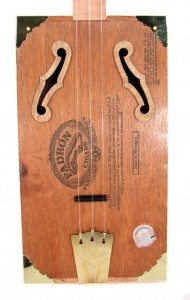 A Cigar Box Guitar (CBG) can range widely when it comes to decoration. The most basic, primitive CBGs have very little decoration; reduced to its most basic form, a CBG is a stick, a box and a couple of strings, without any need for show adornment.
A Cigar Box Guitar (CBG) can range widely when it comes to decoration. The most basic, primitive CBGs have very little decoration; reduced to its most basic form, a CBG is a stick, a box and a couple of strings, without any need for show adornment.
While there is definitely nothing wrong with that austere simplicity, many builders enjoy adding some decorative touches to their builds. Many cigar boxes start off as pretty decorative pieces anyway, so it is natural to try to build upon that when creating a handmade instrument from one.
The purpose of this article is to discuss some of the methods you can use to decorate your builds, and wherever possible to use hardware that is both decorative AND useful – using a decorative brass hinge as a tailpiece, for instance. Where appropriate we’ll link to items that we have for sale in our web shop that you can use to help dress up your own builds. We’ll divide the CBG up into four basic sections: the headstock, neck, sound box and tail/base, and discuss some ideas and options for each in turn. Keep in mind as you go along that many of the decorative parts mentioned in this article are available at great prices in our C. B. Gitty Crafter Supply Web Store.
The Headstock
The headstock is at the top of the neck, and usually a good amount of it is taken up by your machine heads/tuners. As such the options for decoration can be somewhat limited, but depending on your headstock design there are still a number of options you can choose from. Keep in mind that the front, back and sides of the headstock are all open for decoration, and that it can be especially effective if a design pattern started on the headstock continues on down the neck.
Wood-burning
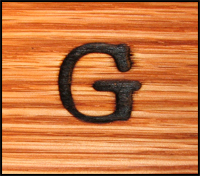 This is a means of decoration that we will mention repeatedly in this article. It is cheap and easy, and with a bit of patience can yield some very good results. You can wood-burn your name (or trade name) into the headstock, or burn in a design which can continue on up the neck if you desire. If you are not of an artistic bent, you can always get some carbon paper and trace a complex design onto the headstock, and then wood-burn that. A vine/leaf motif that runs up the neck and flowers on the headstock is one idea that we have used on our builds to good effect. You can also get letter kits for your wood-burner that allow you to burn letters, numbers and symbols.
This is a means of decoration that we will mention repeatedly in this article. It is cheap and easy, and with a bit of patience can yield some very good results. You can wood-burn your name (or trade name) into the headstock, or burn in a design which can continue on up the neck if you desire. If you are not of an artistic bent, you can always get some carbon paper and trace a complex design onto the headstock, and then wood-burn that. A vine/leaf motif that runs up the neck and flowers on the headstock is one idea that we have used on our builds to good effect. You can also get letter kits for your wood-burner that allow you to burn letters, numbers and symbols.
Branding
A step up from wood-burning, you can have custom metal brands made that you can use to brand words or designs into your headstock (and the rest of your build). A good use of this on the headstock would be to have a fairly small brand made with either your logo or your trade name. This would allow you to consistently brand each build you produce with the same design.
 Tuner Bushings
Tuner Bushings
Though most tuners come with matched bushings/ferules, the economy tuners we sell offer you the choice of different metal finishes on the ferrules, so you can get the exact look you want. Instead of the basic nickel, you could instead go for brass, matte black or antique copper, all of which can offer a different, distinct look to your headstock.
Vintage Coins
Setting a vintage coin into your headstock can be a very cool and unique accent, as shown in the photo of one of our builds. For many people CBGs are seen as a throwback to an earlier era anyway, so including some vintage coins from that era (for the United States think Indian head or wheat pennies, buffalo nickels, mercury dimes, etc.). You can get away with using very worn coins that don’t have much inherent value (look for coins listed as “cull” or in “fair” or “almost good” condition), and a quick turn on the buff wheel can polish them 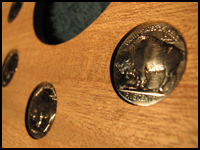 right up.
right up.
Metal Hardware
There are a host of possibilities when it comes to dressing up your headstock with metal hardware. Brass door pull plates can be screwed on, small grommets/bushings can be set into it in a decorative pattern; coins, metal scrapbooking accents and other small metal decorations can be screwed/tacked/glued on; you can even carve your own unique metal pieces out of brass, copper or aluminum. Always keep your eyes open at the hardware or craft store, as you can often find items meant for other uses that would make very nice decorative accents for your CBG.
Other
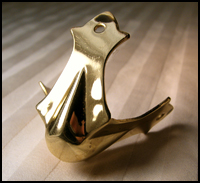 Like with most things CBG-related, you can let your imagination run wild. Beads, feathers, semiprecious stones, jewelry… the options for what you could nail, screw or glue to your headstock are nearly endless. The only real “rule” is that you shouldn’t do anything that will affect the headstock’s ability to do its job: don’t overly weaken the structural integrity of the headstock and its ability to stand up to the tension of the strings; don’t put anything on that will raise up the strings or block their path to the tuner pegs; and don’t do anything that will prevent the tuners from tightening the strings properly.
Like with most things CBG-related, you can let your imagination run wild. Beads, feathers, semiprecious stones, jewelry… the options for what you could nail, screw or glue to your headstock are nearly endless. The only real “rule” is that you shouldn’t do anything that will affect the headstock’s ability to do its job: don’t overly weaken the structural integrity of the headstock and its ability to stand up to the tension of the strings; don’t put anything on that will raise up the strings or block their path to the tuner pegs; and don’t do anything that will prevent the tuners from tightening the strings properly.
The Neck
The neck may seem pretty limited when it comes to decoration, but there are quite a few things you can do to spruce it up. The biggest deciding factor is whether or not your neck is fretted. Unfretted necks are pretty much empty slates when it comes to decoration, especially if you are going to set it up with quite high action for playing with a slide. If your neck is fretted, then your options are more limited, but there is still quite a bit you can do. We’ll present some ideas below.
Fret Markers (fretted neck)
If your neck is fretted, then you will want to mark certain key frets – the 3rd (optional), fifth, seventh, tenth, twelfth and fifteenth, for example. These frets can be marked both on the surface of the fret board as well as the side of the neck – many store-bought guitars have these markings, and some of them are quite decorative, such as inlaid pearl designs. For your CBG, you can do a number of things, from a very simple black dot with a sharpie, to drilling a hole and gluing in a plug of wood or a piece of metal bar stock. If gluing in a wooden plug, be sure to use a contrasting wood: if your neck is maple, use walnut, etc. Brass or aluminum bar inserts always look nice as well. You can also use colored plastic rod as an insert. You could even inset a vintage coin if you wanted, though you would have to be careful with how you drilled the hole to set it in, as a spade bit might go through your neck and out the back.
If you want to keep it simpler, you can get the wood-burner back out and create your own distinct designs; or you can get a custom fret marker brand made! Many guitar makers will do something a little different on the twelfth fret, such as two dots instead of one, as the twelfth fret is special.
 Fret Markers (unfretted neck)
Fret Markers (unfretted neck)
On an unfretted neck, most players still generally like to have at least some of the frets marked out, as a guide for when they are playing slide. Or you can mark out all of the frets with a wood-burner or other method if you want. Generally, at least the fifth, seventh and twelfth fret positions should be indicated, since these are frequently used in blues and other musical forms. As mentioned, you could mark these positions with wood-burnt lines, inset plugs/rods, or other indicators.
Beyond the fret markers, if a guitar is going to be set up for slide playing you can get even more creative with the fret board, wood-burning in designs, attaching metal hardware, setting in vintage coins, etching/carving designs, etc. It can also be a good place to carve/burn/brand in your trade name – between the seventh and twelfth fret markers being a good spot for it. The options are virtually endless!
Other Decorations
As mentioned above, wood-burnt (or carved) motifs that run up the neck and onto the headstock can be very attractive. For example, picture a vine motif that starts on the body of the instrument, winds its way up around the neck (both front and back) and then ends up on the headstock. If you are going to put some sort of clear finish on your neck (and assuming it is a lighter wood), you could attempt some sort of inked designs, or even written text – the idea of iron-on inkjet transfers also presents some interesting possibilities.
Generally the only rules for the neck are that you don’t want to compromise its structural integrity, and you don’t want anything that is going to interfere with the strings’ ability to vibrate. Also, when considering attaching hardware to the back/sides of the neck, think about how it will affect the ability to play the instrument. This is only a concern if your goal is a playable instrument — if you are building wall art, it is not such a concern.
The Sound Box (Body)
The sound box is the body of the instrument and for a CBG it consists of a cigar box. Cigar boxes come in a wide range of styles, sizes and shapes, with greater or lesser degrees of decoration. Some are fairly simple bare wood boxes with some simple logos/text branded into the surface. Others are large, intricately ornate pieces of art. These fancier boxes tend to be a lot harder to get ahold of, reserved for the most expensive cigars and special limited-edition releases.
While the sound box is (usually) the largest part of a CBG, it is also usually the part that doesn’t NEED as much decoration, as it tends to already have its own decoration that makes it immediately recognizable as a cigar box. You probably don’t want to tack on so much stuff that it is no longer recognizable (though of course you can if you want), so the challenge becomes how to tastefully add some decorative elements to help jazz it up a bit. This is especially true if you have a simpler cigar box that doesn’t have a lot of decoration already.
There are several fairly straightforward ways that the sound box can be dressed up without seriously altering the look and feel of the cigar box, which we present below.
The Neck Join
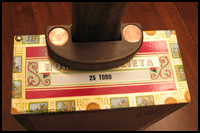 Sometimes the area where the neck joins/enters the sound box can end up with some uneven/unsightly edges. This is a perfect place to apply some creativity to cover the rough area and improve the overall appeal of the instrument. For the top of the box, a brass flat door pull can go very well here, as can some of the rusted tin accents we sell in our web store. You could also cut a thin piece of hardwood and wood-burn/carve it and then place it over this area, or just attach it without decoration. For the sides of the box where the neck goes through, you can also form a sort of “heel” or collar out of wood (or other material) to go around the neck where it enters the box. This can help cover up the uneven edges, as well as help reinforce the neck.
Sometimes the area where the neck joins/enters the sound box can end up with some uneven/unsightly edges. This is a perfect place to apply some creativity to cover the rough area and improve the overall appeal of the instrument. For the top of the box, a brass flat door pull can go very well here, as can some of the rusted tin accents we sell in our web store. You could also cut a thin piece of hardwood and wood-burn/carve it and then place it over this area, or just attach it without decoration. For the sides of the box where the neck goes through, you can also form a sort of “heel” or collar out of wood (or other material) to go around the neck where it enters the box. This can help cover up the uneven edges, as well as help reinforce the neck.
The Sound Hole(s)
Unless your CBG is a completely electric build, you are likely to have at least one sound hole drilled in your box to help it project sound. While you can of course leave these holes bare, it can be a very nice touch to insert a brass (or other metal) grommet to decorate the hole and cover any rough edges. Of course this is only applicable if you have standard round sound holes – if you have cut F-holes into your box, you’re on your own. We sell a nice variety of grommets in various sizes in our web store – from
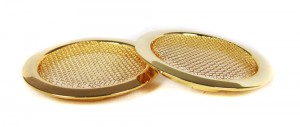 1/4″ bushings in 4 finishes (nickel, brass, matte black and copper) up through jumbo 2″ inside diameter brass grommets, we’re sure to have what you need for your sound hole decoration needs! (Side note: the bigger grommets also make GREAT speaker hole covers for cigar box amplifiers!).
1/4″ bushings in 4 finishes (nickel, brass, matte black and copper) up through jumbo 2″ inside diameter brass grommets, we’re sure to have what you need for your sound hole decoration needs! (Side note: the bigger grommets also make GREAT speaker hole covers for cigar box amplifiers!).
Another option to consider is drilling a number of smaller holes and using small 1/4″ or 3/8″ bushings as inserts, instead of a single larger sound hole. This can allow you to actually create a decorative design which can look really nice – though the practicality of this of course depends on the design of your cigar box. This same idea, of using smaller sound holes, can also be used to work with and compliment your box’s cover design.
The Back
People don’t generally think about the back of the CBG as a good place for decoration, and for good reason – it is almost guaranteed to be the least-often seen part of the instrument. However, there is no reason to ignore the back entirely. It can be an especially good place for some custom branding, or a good place to sign and number your special build or dedicate it to someone.
Refinishing the Box
Sometimes you want to completely redesign your cigar box from the ground up. In this case, you can strip it down to bare wood, sand off any branding, and start from scratch. Builders have painted all sorts of things on their boxes, from long-dead fathers of the blues to landscapes to abstract art and more. When you go this route, you truly have full artistic control over what your build will end up looking like, and you are guaranteed to end up with something unique.
Hardware Add-Ons
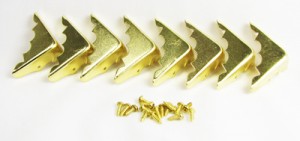 There are many things you can tack onto your box to add some decorative appeal. The list below outlines some ideas to help get you started, but a word of warning: if you get into this you may soon find that you are looking at the world in a new way. Everywhere you go, from the hardware store to the supermarket to a yard sale, you will be looking at stuff in terms of how it can be used on your next build!
There are many things you can tack onto your box to add some decorative appeal. The list below outlines some ideas to help get you started, but a word of warning: if you get into this you may soon find that you are looking at the world in a new way. Everywhere you go, from the hardware store to the supermarket to a yard sale, you will be looking at stuff in terms of how it can be used on your next build!
Box Corners
Box corners are one of the best ways to spruce up your sound box. Putting a brass corner on each of the 8 corners of the box (4 on the top, 4 on the bottom) not only looks great, but it can help protect your box corners from wear and tear. These corners come in many styles, including two that we carry in our store: simple brass box corners, and solid
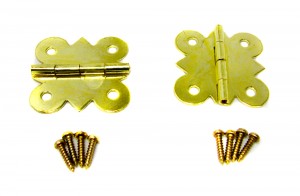 brass trunk corners. These trunk corners can keep the surface of your box up off of a flat surface by about 1/4″, and look really great.
brass trunk corners. These trunk corners can keep the surface of your box up off of a flat surface by about 1/4″, and look really great.
Custom Latches/Hinges
The latch and hinges of a cigar box can often be pretty chintzy, and this is a great opportunity to upgrade to something that will look a lot better. You can replace the thin press-in hinges and simple latch with more solid and decorative versions, which will not only strengthen your instrument but also look great.
Other Accents
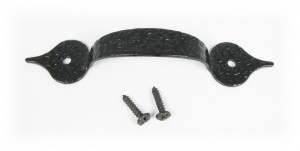 Attaching metal accents such as coins, scrapbooking embellishments, brass door hardware or other items can really add a lot to your sound box. If you are building with a specific theme in mind, such as steampunk or automotive, then you can add items and designs specific to that theme. As mentioned above, you will find that there are a lot of products and items out there in the world that can be used on CBGs, from sink drain screens to door hardware to recycled electronics components and more. The only limitation is your creativity!
Attaching metal accents such as coins, scrapbooking embellishments, brass door hardware or other items can really add a lot to your sound box. If you are building with a specific theme in mind, such as steampunk or automotive, then you can add items and designs specific to that theme. As mentioned above, you will find that there are a lot of products and items out there in the world that can be used on CBGs, from sink drain screens to door hardware to recycled electronics components and more. The only limitation is your creativity!
Things to Avoid
Although the sound box is full of possibilities for decoration and embellishment, there are a few things you will want to avoid. First, you really shouldn’t do anything that will interfere with the strings and their ability to vibrate, unless your goal is to make a pseudo-instrument for hanging on a wall as art. The ability of the strings to fully and properly vibrate is critical to the instrument’s tone. Likewise, don’t add so much stuff that the instrument can’t be comfortably held and played. There shouldn’t be any obstructions on the face of the instrument in the path where a player’s picking hand and arm tend to make contact. No matter how cool they look, anything that obstructs or inconveniences the player is not a good idea.
The Tail/Base
This is the “bottom” of the instrument, where the strings attach to the box, and where the end of the neck protrudes if you are using the neck-through building style. There isn’t generally a lot going on down here, but there are still some options for 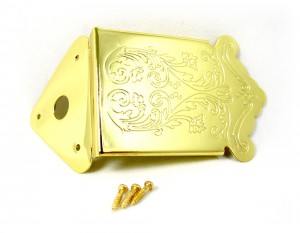 decoration. Some ideas are presented below.
decoration. Some ideas are presented below.
Tailpieces/String Attachment
A tailpiece is a metal or wood piece that mounts to the bottom of the box/end of the neck, and to which the string ends attach. Tailpieces can range in complexity from short lengths of metal pipe, to brass hinges, to reshaped forks and spoons, to simple pieces of wood, to store-bought standard guitar or mandolin tailpieces. Personally, we feel that using a small decorative brass hinge works well. You mount one side of the hinge to the base of the box, and allow the other side to lay over the top. You may need to drill smaller holes in it for your strings to run through, and when it is strung up the hinge will adjust to the angle of the strings as they approach the bridge. This approximates what a “real” tailpiece on a store-bought guitar does, and it works quite well.
If you don’t want to attach a tailpiece, a simple method for neck-through builds is to drill small holes in the base of the neck and run the strings up through them. 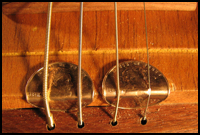 However, you will find that if you don’t add something for protection, once tuned to pitch the strings will cut into the wood. This is a good place to make use of some small bushings, rivet casings or other metal hardware. Not only do they protect the wood from the strings, but they also add a nice decorative touch at the base of the neck. Other builders have used items like brass door pulls, inset coins and brass rod, for this purpose.
However, you will find that if you don’t add something for protection, once tuned to pitch the strings will cut into the wood. This is a good place to make use of some small bushings, rivet casings or other metal hardware. Not only do they protect the wood from the strings, but they also add a nice decorative touch at the base of the neck. Other builders have used items like brass door pulls, inset coins and brass rod, for this purpose.
Strap Attachment
If you are going to be attaching a strap to your CBG for playing standing up, you will probably be attaching one end of it to the base/tail of the instrument. Most straps are made to tie onto the upper part of the neck at the top, and go over a button of sorts at the bottom. Of course you can attach an actual strap button to the base for this, or you can come up with a homemade solution. One thing we have used on our builds is drilling a hole through a wheat penny and then screwing that to the
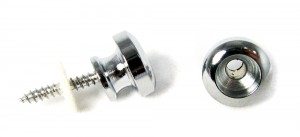 box, using a couple of small nuts as spacers.
box, using a couple of small nuts as spacers.
Other Decoration
As with most other areas of the instrument, the options for additional decoration here are pretty wide open. Many of the ideas that we mentioned above for the sound box also apply to this area, and you can also get creative with adding hardware to help the instrument stand up safely when leaned against a wall. This is also a good area for attaching dangling items such as beads, feathers, totems, voodoo charms, or shrunken heads, if you are into that sort of thing.
Things to Avoid
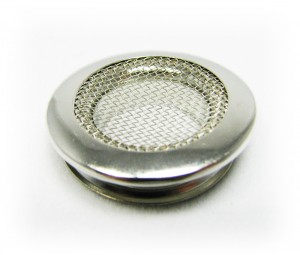 About the only things you’ll want to avoid down at the base of the instrument is anything that will make it difficult (or even impossible) to replace strings. You also don’t want anything to obstruct the path of the strings from the tailpiece/attachment area to the bridge.
About the only things you’ll want to avoid down at the base of the instrument is anything that will make it difficult (or even impossible) to replace strings. You also don’t want anything to obstruct the path of the strings from the tailpiece/attachment area to the bridge.
Also it is always best if you design your string attachment method such that individual strings can be changed without all of them having to be loosened and removed. It can be a real pain for a player if he or she has to remove all of the strings to replace just one of them when they break.
Summary
This has, believe it or not, been a brief overview of some of the possible decorations you can add to your cigar box guitar build. As you progress in this hobby, you will likely find, like most of us have, that your ideas quickly outpace your ability to finish builds. That is OK! Keeping good notes can help, or you can just dive into each build and see what comes out – it’s up to you.
We hope you have found this article useful and that you’ve gotten a useful idea or two out of it. Be sure to check out our other articles related to building and playing Cigar Box Guitars, and also be sure to check out our store full of CBG parts and accessories!

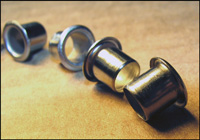 Tuner Bushings
Tuner Bushings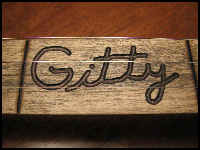 Fret Markers (unfretted neck)
Fret Markers (unfretted neck)
This would be a good question to ask on CigarBoxNation.com, a lot of builders hang out there.
If I have the cigar box can anyone make me a guitar, violin, or banjo?